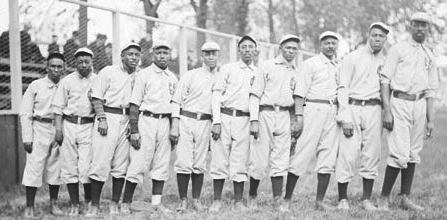Negro League baseball has history in northern Illinois

Negro League Baseball Players Association
The Chicago Union Giants were born from the Chicago Unions, a Black ballclub that barnstormed the Midwest. They often played white teams from places like Joliet around 1900.
Legendary pitcher Satchel Paige was known for his crazy antics during his career such as having his fielders sit down while he struck out the side or walking people to get to a certain hitter.
In one particular instance, he walked two batters in the 1942 Negro World Series to reach Josh Gibson, one of the best hitters in the league, according to MLB.com.
Gibson’s team climbed back from a 5-0 lead by scoring 4 in the eighth inning. Paige allegedly put the winning run on base to face Gibson.
Paige remained cool and collected and struck out Gibson on three pitches. Many rumors go around that Gibson was able to foul off a few pitches, but the legend remains that Paige was able to strike him out.
This at-bat is one of the best moments in Negro League history. Paige was able to intentionally walk two batters in order to face the best hitter in the league with the potential to drive in the game winning run. For Paige to strike him out reveals how great the players of the Negro Legaues were and how legendary the league was.
The year 2020 marks the 100th anniversary of the Negro Leagues.
On Wednesday, MLB Commisioner Rob Manfred announced that seven professional Negro Leagues would be given Major League status. That means the stats and records of the Negro Leagues are part of MLB history.
While Negro League teams existed throughout the U.S., there are some local ties of Black baseball to this area of Illinois.
In the mid-1800s, African Americans joined in on the excitement of organized baseball. They found their way onto teams with white players and continued to play throughout the war.
Players such as Moses Fleetwood Walker and Bud Fowler were able to put together successful stints with their teams, but their ability to play alongside their white teammates was short lived.
According to the MLB Hall of Fame website, Jim Crow laws and prevalent segregation, in addition to the “gentlemen’s agreements” between owners, forced the Black players out of the league.
In addition to the laws and agreements that were made, many of the white players elected to not play if a Black man was to play with or against them.
For example, Cap Anson of the Chicago White Stockings threatened to cancel a game in the late 1800s that was against Walker’s team if Walker was in the lineup, according to History.com. Protests and complaints such as these from white players encouraged managers to shut out the Black population from the game.
According Patrick Mallory’s 2013 dissertation “The Game They All Played: Chicago Baseball, 1876-1906” for Loyola University-Chicago, Black teams also continued to participate in the semi-professional leagues in Chicago.
The local leagues brought in huge crowds and the games were played in any condition, rain or shine. This became a huge attraction and the spectators enjoyed watching the players.
The Black teams even played against white teams and often dominated them. According to Mallory, the Chicago Unions, arguably the top-ranked Black ballclub in the West, squared off against the formidable Standards, a white semi-professional team from Joliet, in 1899. By the end of the game, the score was 20-4 in favor of the Unions.
The Unions also played Northwestern University’s varsity team that same year in Evanston. The Unions won 11-5.
The Unions became the Union Giants and played in the Chicago League, and later the Leland Giants would participate in the Chicago City League.
Although they often beat white teams, the Black men on the teams were discriminated against in the press and their play style was often described as using tricks to win games.
With the growing racism and segregation in the world of baseball, a man named Rube Foster decided that there was a void that needed to be filled. Foster himself was a former pitcher and a highly respected one throughout the league.
In 1920, Foster officially launched the Negro National League and it took off right away. Some games were held in old professional ballparks and drew in more fans than some of the white professional teams, according to the MLB Hall of Fame website. These leagues created a symbolic style that would encourage the African American community to support them.
In 1917, the Chicago Union Giants was sold to Robert P. Gilkerson. Gilkerson went on to rename the team the Gilkerson Union Giants, according to the Negro League Baseball Players Association website.
Gilkerson’d team traveled the Midwest all summer, playing against local teams in small towns. They earned themselves the title of being one of the best barnstorming Black teams in the region through the 1930s.
While the team operated often in Wisconsin, they spent their 1920 spring training in Spring Valley, Ill., a city about 50 miles west of Minooka.
Spring Valley had once been a sundown town, which was a community that did not allow African Americans to reside in it. These communities enforced strict rules that allowed African Americans to come through and work during the day, but required them to leave by sundown.
Throughout the local leagues and the Negro leagues, two main challenges presented themselves. These challenges were Jim Crow laws that allowed segregation and gentlemen’s agreements that prevented Black men from playing alongside white men.
According to the Kansas City Star, the players for the Kansas City Monarchs, one of the most successful Negro League teams, were unable to use a bathroom at an Oklahoma gas station on one of their trips because of their skin color. Jackie Robinson was playing for the Monarchs at the time before he would later join the Brooklyn Dodgers.
Robinson did not back down and decided that if the owner was to deny his use of a bathroom, then he would not give service to the man and buy his gas. He asked the man to take the hose out of the bus.
The man was flustered by this request and knew that this would be a huge profit for his business and that it was not common for a bus of this size to come through needing gas. He allowed Robinson to use the bathroom.
This discrimination was common and forced Black players to suffer during long road trips to games. They often went hungry and could not have games at stadiums.
This discrimination and other challenges continued to haunt Black teams throughout the entirety of their existance.
Although this discrimination occurred frequently and attempted to limit the success of the black teams, the Negro Leagues were able to have huge successes.
In Ken Burns’s 1994 Baseball documentary, former Monarchs player and manager Buck O’Neil said he thought the Negro Leagues could have been the third biggest Black business in the world. O’Neil would later coach and scout for the Chicago Cubs.
Foster’s Negro Natonal League successful because they drew in such big crowds. According to Baseball, a season sometimes drew in close to 400,000 fans. That success prompted other leagues, like the Eastern Colored League, to start up.
The leagues also used their players to create exciting and fun situations that lured in more fans. Paige is a great example of those antics that were performed.
When Jackie Robinson made his debut in the white MLB, it sparked the transition away from the Negro Leagues. More Black men followed in his footsteps because of the higher pay and this would eventually end the Negro Leagues.
The Negro Leagues will remain in history forever as arguably some of the best baseball ever played and those player’s names will not be forgotten.












